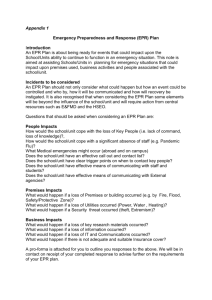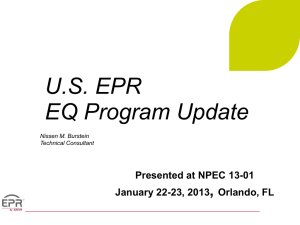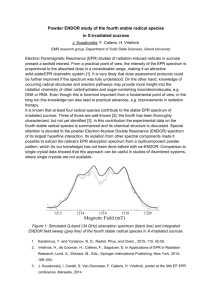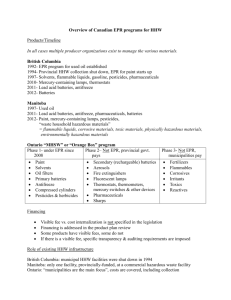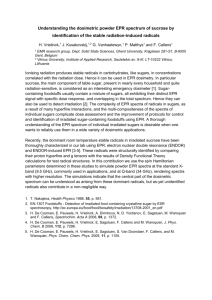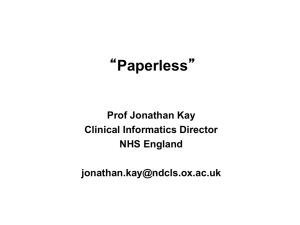How to Write an EPR
advertisement
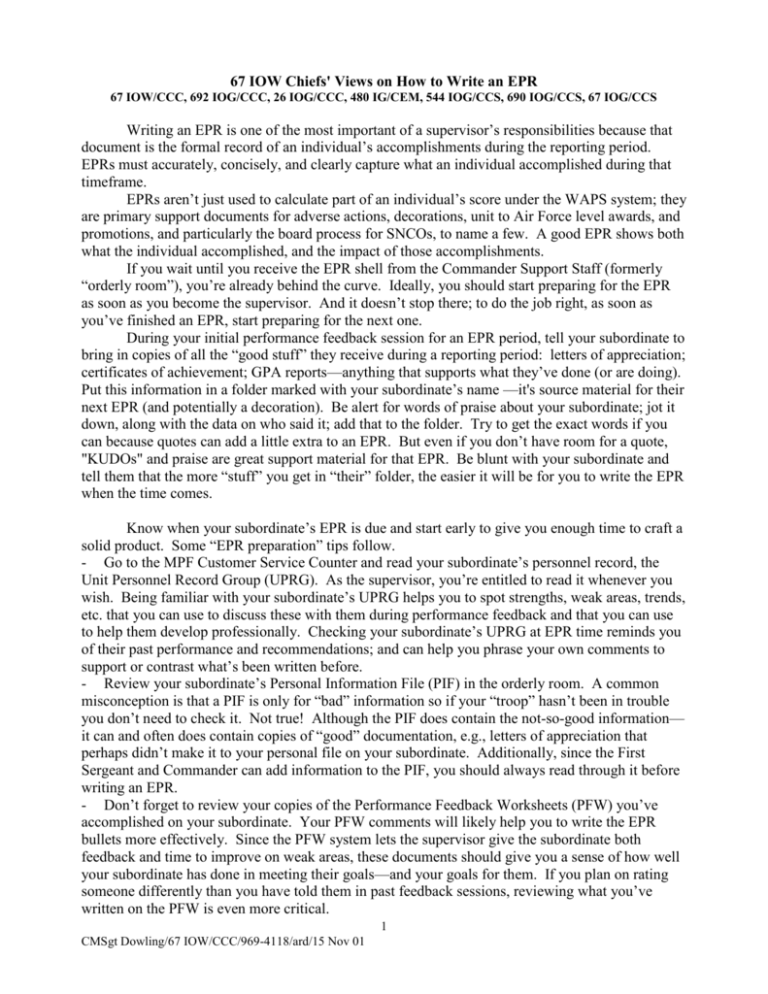
67 IOW Chiefs' Views on How to Write an EPR 67 IOW/CCC, 692 IOG/CCC, 26 IOG/CCC, 480 IG/CEM, 544 IOG/CCS, 690 IOG/CCS, 67 IOG/CCS Writing an EPR is one of the most important of a supervisor’s responsibilities because that document is the formal record of an individual’s accomplishments during the reporting period. EPRs must accurately, concisely, and clearly capture what an individual accomplished during that timeframe. EPRs aren’t just used to calculate part of an individual’s score under the WAPS system; they are primary support documents for adverse actions, decorations, unit to Air Force level awards, and promotions, and particularly the board process for SNCOs, to name a few. A good EPR shows both what the individual accomplished, and the impact of those accomplishments. If you wait until you receive the EPR shell from the Commander Support Staff (formerly “orderly room”), you’re already behind the curve. Ideally, you should start preparing for the EPR as soon as you become the supervisor. And it doesn’t stop there; to do the job right, as soon as you’ve finished an EPR, start preparing for the next one. During your initial performance feedback session for an EPR period, tell your subordinate to bring in copies of all the “good stuff” they receive during a reporting period: letters of appreciation; certificates of achievement; GPA reports—anything that supports what they’ve done (or are doing). Put this information in a folder marked with your subordinate’s name —it's source material for their next EPR (and potentially a decoration). Be alert for words of praise about your subordinate; jot it down, along with the data on who said it; add that to the folder. Try to get the exact words if you can because quotes can add a little extra to an EPR. But even if you don’t have room for a quote, "KUDOs" and praise are great support material for that EPR. Be blunt with your subordinate and tell them that the more “stuff” you get in “their” folder, the easier it will be for you to write the EPR when the time comes. Know when your subordinate’s EPR is due and start early to give you enough time to craft a solid product. Some “EPR preparation” tips follow. - Go to the MPF Customer Service Counter and read your subordinate’s personnel record, the Unit Personnel Record Group (UPRG). As the supervisor, you’re entitled to read it whenever you wish. Being familiar with your subordinate’s UPRG helps you to spot strengths, weak areas, trends, etc. that you can use to discuss these with them during performance feedback and that you can use to help them develop professionally. Checking your subordinate’s UPRG at EPR time reminds you of their past performance and recommendations; and can help you phrase your own comments to support or contrast what’s been written before. - Review your subordinate’s Personal Information File (PIF) in the orderly room. A common misconception is that a PIF is only for “bad” information so if your “troop” hasn’t been in trouble you don’t need to check it. Not true! Although the PIF does contain the not-so-good information— it can and often does contain copies of “good” documentation, e.g., letters of appreciation that perhaps didn’t make it to your personal file on your subordinate. Additionally, since the First Sergeant and Commander can add information to the PIF, you should always read through it before writing an EPR. - Don’t forget to review your copies of the Performance Feedback Worksheets (PFW) you’ve accomplished on your subordinate. Your PFW comments will likely help you to write the EPR bullets more effectively. Since the PFW system lets the supervisor give the subordinate both feedback and time to improve on weak areas, these documents should give you a sense of how well your subordinate has done in meeting their goals—and your goals for them. If you plan on rating someone differently than you have told them in past feedback sessions, reviewing what you’ve written on the PFW is even more critical. 1 CMSgt Dowling/67 IOW/CCC/969-4118/ard/15 Nov 01 The EPR, AF Forms 910 and 911 Part of the EPR process includes ensuring the information on the document is correct. Fill in Block I data from the EPR shell. If information has changed or is incorrect, get with the orderly room and ensure the changes are made in PC-III; then get an updated EPR shell. Read through the word picture by each block on the front of the EPR as you start to both consider which block to check and get an idea for bullets on the back. Information in Block II is important. Is the duty title correct? Don’t try to inflate it; a duty title should clearly be linked to your subordinate’s responsibilities in the job description section. Check over the job description for accuracy. It doesn’t have to be a “canned” description; write it so that your subordinate’s responsibilities are clearly delineated, including the amount of resources (money and personnel) they manage and any additional duties they’re responsible for. A key factor in Block III is the word picture by each rating block. Rate your subordinate accurately. Although the temptation may be to simply “firewall” the rating—give them the rating they’ve earned. Remember, your PFW sessions should have left them no doubt about where you’d rate them and given them feedback on improvements they’ve needed, as well as the time to do so; mark the block honestly. Now for the bullets in Blocks V through VII. To do these right, you’ll probably have to put in some time. And you have to write succinctly: Block V, the rater’s block, only holds thirteen lines; Block VI, the rater’s rater’s section, has only six lines; and Block VI, the indorser’s block for SNCOs, contains only five lines. That’s not very much space to hold a year’s worth of accomplishments…but it’s your job to see that you fit the most important information into the bullets each block. EPR Bullets - Each bullet needs to be written to show an action/accomplishment linked to a result/impact. The action/accomplishment covers what they did (and the significance if it’s not immediately or intuitively clear). The result of the action and its should show the impact of what they did on the office, flight, unit, mission, base, MAJCOM, service, or DoD. - Clarify what the individual did; use verbs whenever possible, i.e., “managed,” “directed,” “authored,” etc. - Put the impact up front instead in the bullet (e.g., “NCO of the Quarter, best of 212 NCOs in the Group”) instead of at the end (Best of 212 NCOS in the Group, earned NCO of the Quarter) - Write so the accomplishment is clear to someone who’s not in the organization, command, or career field. For example, “Sensor Olympics gold medal winner” means something to someone who’d been in AIA for a while but probably no one outside of AIA will recognize the importance of that award. However, “Best in command--#1 of 480 in his AFSC” is clear to anyone. - .Don’t leave room for doubt. Examples: “Participated in” could mean anything from “showed up” to “directly managed the operation.” “Member of unit Top-3”…does he just pay their dues; pay his dues and show up at meetings occasionally; or does he get involved and plan, organize, and manage Top-3 activities? - Watch out for “empty” bullets. “Recruiting poster-perfect NCO; leader and mentor, peers and subordinates look up to her,” does sound nice. However, without action-impact—what did she do and the impact of what she did—the bullet is only the rater’s opinion, it's not backed up by fact. - Regarding impact, remember the “so what” factor. A bullet's impact should be clear to anyone who reads the EPR. Be wary of using terms or abbreviations that are common only to a career field, 2 site, or mission. Similarly, use mission names judiciously; the significance of the operation may not be Air Force-wide and will likely fade over time. If the operation is critical to understanding bullets, clarify it, e.g., “OPERATION NORTHERN WATCH (ONW), monitoring Iraqi no-fly zones.” However, it’s often much better to substitute the mission and geography for operation name. For example, OPERATION NOBLE ANVIL (ONA) says reams to someone from USAFE or who performed combat or “reachback” operations during the Kosovo air war. However, the term ONA loses its significance with anyone who didn’t participate—for instance, many who are in PACAF. Furthermore, remember we’ve been operating in a “contingency rich” environment for some time. Two years from now, it will likely be difficult for many of those not directly involved in ONA to identify the operation, much less the significance of the mission. As examples, are the missions accomplished in OPERATION FIREY VIGIL or OPERATION SEA ANGEL immediately recognizable? What’s the difference between PROVIDE COMFORT, PROVIDE HOPE, AND PROVIDE RELIEF? - Remember; bullets telegraph information so they don’t have to follow strict compositional rules or be written as a grammatically correct English sentence. For example, substituting commas or semicolons for “and;” and using articles such as “a,” “an,” or “the” only when clarity demands their use will both reduce bullet length and probably focus more attention on the action and impact. - To be most effective, keep bullets at one or two lines in length. A three-line bullet is almost always too long. Why? These bullets often contain “filler” that can be edited to streamline the prose or are written as grammatically correct sentences instead of bullets. - Limit the “white” space at the end of the line (i.e., no more than a few characters) whenever possible. This ensures the action-result of the bullet is clear. Furthermore, too much white space in an EPR block can lead a very critical reader to assume there wasn’t enough “meat” to fill up the bullet or the block. However, don’t use “fluff;” to fill up a line; you can bury a clearly written action-impact that way. - Use sub-bullets sparingly, they reduce the amount of usable space on the line; a two-line bullet is usually better. Stratify, Quantify, Why. - Stratify. "One of my best..." has little value other than it shows the individual is well thought of. Stratifying them among a specific group adds tremendous impact, i.e., "Top 2%," "In the top 3," "Best of " etc. - Quantify. To improve your stratification, quantify, quantify, quantify. "Top 2% of my 57 TSgts," "In the top 3 of my 113 analysts," "Best of my 25 SNCOs." Use numbers, dollars, percentages, etc. Percentages have more impact if you clarify the scope: “increased reporting by 10 percent” could bean an increase of one if the baseline is ten. “Increased reporting 10 percent— from 900 to over 990” has much more quantifiable impact. - Why. To improve quantification and stratification, explain why you ranked someone the way you did, i.e., "Top 2% of my 57 TSgts; she leads and manages like a seasoned MSgt," "In the top 113 of my analysts, he sent out 80% of our 2,205 reports this quarter with zero errors," or "Best of my 25 SNCOs, she garnered Sq SNCO of the Year for the past 3 years." - Don’t speak above your level, i.e., squadrons talk about squadrons, etc. (e.g., squadron-level bullets shouldn’t say “best in the Wing” - Focus on leadership and management. This is critical for promotion to SMSgt and CMSgt— the E-8 and E-9 boards aren’t looking for senior technicians—they key on leadership and management skills because that’s where Senior Master Sergeants and Chiefs will function. Keep firmly in mind that one of our responsibilities as supervisors is to develop leaders—so leadership and management accomplishments need to be showcased in any EPR. Don’t forget that since 3 boards review 10 years of EPRs, it is particularly important to document this in EPRs for TSgt and above. - If you're making recommendation for an indorsement, be sure to cite a source for your comments. For instance, if you recommend using the line “best in the wing,” the individual should have won a wing award, i.e., a quarterly or annual award, or in some way been recognized or designated as the best in a specific group. - The last line in each block--and particularly in the final rater's block or Senior Rater's block-should contain solid, “impact” job recommendation and/or promotion recommendation. Provide support for the statement, i.e., in order to use “Best in the Wing,” the individual should have won a Wing-level award (i.e., NCO of the Quarter, SNCO of the Year, Best Supply Technician of the year, etc.) Although using these guidelines will help, there is no magic, cookie cutter method to writing a good EPR—like anything else worth doing well, it takes effort and practice. But the end result is worth it—and is the “taking care of people” part of “Mission first—People Always.” 4
